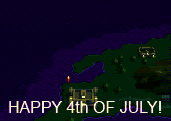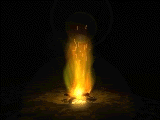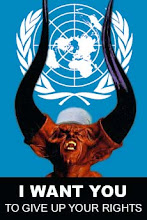------------ --------- --------- --------
(Entry-level material for students of the Outer Hall, adapted from the 25th degree lecture "Knight of the Brazen Serpent" in "Morals and Dogma" of Scottish Freemasonry - pgs 442-447, by Albert Pike.)

Like most nations and religions, Jews have been subverted from within. Zionists are pawns of the Sabbateans who used the "holocaust" to engineer the creation of Israel. Millions of Jews been "sacrificed" to create a Sabbatean Homeland, a "burnt offering" to Satan.
"To the ancients, as yet inventors of no astronomical instruments, and looking at the Heavens with the eyes of children, this earth was a level plain of unknown extent. About its boundaries there was speculation, but no knowledge. The inequalities of its surface were the irregularities of a plane. That it was a globe, or that anything lived on its under surface, or on what it rested, they had no idea. Every twenty-four hours the sun came up from beyond the Eastern rim of the world, and travelled across the sky, over the earth, always South of, but sometimes nearer and sometimes further from the point overhead; and sunk below the world's Western rim. With him went light, and after him followed darkness.
And every twenty-four hours appeared in the Heavens another body, visible chiefly at night, but sometimes even when the sun shone, which likewise, as if following the sun at a greater or less distance, travelled across the sky; sometimes as a thin crescent; and thence increasing to a full orb resplendent with silver light; and sometimes more and sometimes less to the Southward of the point overhead, within the same limits as the Sun.


Man, enveloped by the thick darkness of profoundest night, when everything around him has disappeared, and he seems alone with himself and the black shades that surround him, feels his existence a blank and nothingness, except so far as memory recalls to him the glories and splendors of light. Everything is dead to him, and he, as it were, to Nature. How crushing and overwhelming the thought, the fear, the dread, that perhaps that darkness may be eternal, and that day may possibly never return; if it ever occurs to his mind, while the solid gloom closes up against him like a wall ! What then can restore him to like, to energy, to activity, to fellowship and communion with the great world which God has spread around him, and which perhaps in the darkness may be passing away' LIGHT restores him to himself and to nature which seemed lost to him. Naturally, therefore, the prim itive men regarded light as the principle of their real existence, without which life would be but one continued weariness and despair. This necessity for light, and its actual creative energy, were felt by all men: and nothing was more alarming to them than its absence. It became their first Divinity, a single ray of which, flashing into the dark tumultuous bosom of chaos, caused man and all the Universe to emerge from it. So all the poets sung who imagined Cosmogonies; such was the first dogma of Orpheus, Moses, and the Theologians. Light was Ormuzd, adored by the Persians, and Darkness Ahriman, origin of all evils. Light was the life of the Universe, the friend of man, the substance of the Gods and of the Soul.
The sky was to them a great, solid, concave arch; a hemisphere of unknown material, at an unknown distance above the flat level earth; and along it journeyed in their courses the Sun, the Moon, the Planets, and the Stars.
The Sun was to them a great globe of fire, of unknown dimensions, at an unknown distance. The Moon was a mass of softer light; the stars and planets lucent bodies, armed with unknown and supernatural influences.
It could not fail to be soon observed, that at regular intervals the days and nights were equal; and that two of these intervals measured the same space of time as elapsed between the successive inundations, and between the returns of spring-time and harvest. Nor could it fail to be perceived that the changes of the moon occurred regularly; the same number of days always elapsing between the first appearance of her silver crescent in the West at evening and that of her full orb rising in the East at the same hour; and the same again, between that and the new appearance of the crescent in the West.


It was also soon observed that the Sun crossed the Heavens in a different line each day, the days being longest and the nights shortest when the line of his passage was furthest North, and the days shortest and nights longest when that line was furthest South: that his progress North and South was perfectly regular, marking four periods that were always the same,-those when the days and nights were equal, or the Vernal and Autumnal Equinoxes; that when the days were longest, or the Summer Solstice and that when they were shortest, or the Winter Solstice.
With the Vernal Equinox, or about the 25th of March of our Calendar, they found that there unerringly came soft winds, the return of warmth, caused by the Sun turning back to the Northward from the middle ground of his course, the vegetation of the new year, and the impulse to amatory action on the part of the animal creation, when the Bull and the Ram, animals most valuable to the agriculturist, and symbols themselves of vigorous generative power, recovered their vigor, the birds mated and builded their nests, the seeds germinated, the grass grew, and the trees put forth leaves. With the Summer Solstice, when the Sun reached tile extreme northern limit of his course, came great heat, and burning winds, and lassitude and exhaustion; then vegetation withered, man longed for the cool breezes of Spring and Autumn, and the cool water of the wintry Nile or Euphrates, and the Lion sought for that element far from his home in the desert.
With the Autumnal Equinox came ripe harvests, and fruits of the tree and vine, anti falling leaves, and cold evenings presaging wintry frosts; anti the Principle and Powers of Darkness, prevailing over those of Light, drove the Sun further to the South, so that the nights grew longer than the days. And at the Winter Solstice the earth was wrinkled with frost, the trees were leafless, and the Sun, reaching the most Southern point in his career, seemed to hesitate whether to continue descending, to leave the world to darkness and despair, or to turn upon his steps and retrace his course to the Northward, bringing back seed-time and Spring, and green leaves and flowers, and all the delights of love.
Thus, naturally and necessarily, time was divided, first into days, and then into moons or months, and years; and with these divisions and the movements of the Heavenly bodies that marked them, were associated and connected all men's physical enjoyments and privations. Wholly agricultural, and in their frail habitations greatly at the mercy of the elements and the changing seasons, the primitive people of the Orient were most deeply interested in the recurrence of the periodical phenomena presented by the two great luminaries of Heaven, on whose regularity all their prosperity depended.
And the attentive observer soon noticed that the smaller lights of Heaven were, apparently, even more regular than the Sun and Moon, and foretold with unerring certainty, by their risings and settings, the periods of recurrence of the different phenomena and seasons on which the physical well-being of all men depended. They soon felt the necessity of distinguishing the individual stars, or groups of stars, and giving them names, that they might understand each other, when referring to and designating them. Necessity produced designations at once natural and artificial. Observing that, in the circle of the year, the renewal and periodical appearance of the productions of the earth were constantly associated, not only with the courses of the Sun, but also with the rising and setting of certain Stars, and with their position relatively to the Sun, the centre to which they referred the whole starry host, the mind naturally connected the celestial and terrestrial objects that were in fact connected: and they commenced by giving to particular Stars or groups of Stars the names of those terrestrial objects which seemed connected with them; and for those which still remained unnamed by this nomenclature, they, to complete a system, assumed arbitrary and fanciful names.
Thus the Ethiopian of Thebes or Saba styled those Stars under which the Nile commenced to overflow, Stars of Inundation, or that poured out water (AQUARIUS).
Those Stars among which the Sun was, when he had reached the Northern Tropic and began to retreat Southward, were termed, from his retrograde motion, the Crab (CANCER).
As he approached, in Autumn, the middle point between the Northern and Southern extremes of his journeying; the days and nights became equal; and the Stars among which he was then found were called Stars of the Balance (LIBRA).
Those stars among which the Sun was, when the Lion, driven from the Desert by thirst, came to slake it at the Nile, were called Stars of the Lion (LEO).
Those among which the Sun was at harvest, were called those of the Gleaning Virgin, holding a Sheaf of wheat (VIRGO).
Those among which he was found in February, when the Ewes brought forth their young, were called Stars of the Lamb (ARIES).
Those in March, when it was time to plough, were called Stars of the Ox (TAURUS).
Those under which hot and burning winds came from the desert, venomous like poisonous reptiles, were called Stars of the Scorpion (SCORPIO).
Observing that the annual return of the rising of the Nile was always accompanied by the appearance of a beautiful Star, which at that period showed itself in the direction of the sources of that river, anti seemed to warn the husbandman to be careful not to be surprised by the inundation, the Ethiopian compared this act of that Star to that of the Animal which by barking gives warning of danger, and styled it the Dog (SIRIUS).
Thus commencing, and as astronomy came to be more studied, imaginary figures were traced all over the Heavens, to which the different Stars were assigned. Chief among them were those that lay along the path which the Sun travelled as he climbed toward the North and descended to the South: lying within certain limits and ex-tending to an equal distance on each side of the line of equal nights and days. This belt, curving like a Serpent, was termed the Zodiac, and divided into twelve Signs.
At the Vernal Equinox, 2455 years before our Era, the Sun was entering the sign and constellation Taurus, or the bull; having passed through, since he commenced, at the winter Solstice, to reascend Northward. the Signs Aquarius, Pisces and Aries; on entering the first of which he reached the lowest limit of his journey Southward.
From TAURUS, he passed through Gemini and Cancer, and reached Leo when he arrived at the terminus of his journey Northward. Thence, through Lee, Virgo, and Libra, he entered Scorpio at the Autumnal Equinox, and journeyed Southward through Scorpio, Sagittarius, and Capricornus to AQUARIUS, the terminus of his journey South.
The path by which he journeyed through these signs became the Ecliptic; and that which passes through the two equinoxes, the Equator.
They knew nothing of the immutable laws of nature; and whenever the Sun commenced to tend Southward, they feared lest he might continue to do so, and by degrees disappear forever, leaving the earth to be ruled forever by darkness, storm, and cold.
Hence they rejoiced when he commenced to re-ascend after the Winter Solstice struggling against the malign influences of Aquarius and Pisces, and amicably received by the Lamb. And when at the Vernal Equinox he entered Taurus, they still more rejoiced at the assurance that the days would again be longer than the nights, that the season of seed-time had come, and the Summer and harvest would follow.
And they lamented when, after the Autumnal Equinox. the malign influence of the venomous Scorpion, and vindictive Archer, and the filthy and ill-omened He-Goat dragged him down toward the Winter Solstice.
Arriving there, they said he had been slain, and had gone to the realm of darkness. Remaining there three days, he rose again, and again ascended Northward in the heavens, to redeem the earth from the gloom and darkness of Winter, which soon became emblematical of sin, and evil, and suffering; as the Spring, Summer, and Autumn became emblems of happiness and immortality.
Soon they personified the Sun, and worshipped him under the name of Osiris, and transmuted the legend of his descent among the Winter Signs, into a fable of his death, his descent into the infernal regions, and his resurrection.
The Moon became Isis, the wife of Osiris; and Winter, as well as the desert or the ocean into which the Sun descended, became Typhon, the Spirit or Principle of Evil, warring against and destroying Osiris.
From the journey of the Sun through the twelve signs came the legend of the twelve labors of Hercules, and the incarnations of Vishnu and Buddha. Hence came the legend of the murder of Kharum, representative of the Sun, by the three Fellow-crafts, symbols of the three Winter signs, Capricornus, Aquarius, and Pisces, who assailed him at the three gates of Heaven and slew him at the Winter Solstice. Hence the search for him by the nine Fellow-crafts, the other nine signs, his finding, burial, and resurrection.
The celestial Taurus, opening the new year, was the Creative Bull of the Hindus and Japanese, breaking with his horn the egg out of which the world is born. Hence the bull Apis was worshipped by the Egyptians, and reproduced as a golden calf by Aaron in the desert. Hence the cow was sacred to the Hindus. Hence, from the sacred and beneficent signs of Taurus and Lee, the human-headed winged lions and bulls in the palaces at Kouyounjik and Nimroud, like which were the Cherubim set by Solomon in his Temple: and hence the twelve brazen or bronze oxen, on which the laver of brass was supported.
The Celestial Vulture or Eagle, rising and setting with the Scorpion, was substituted in its place, in many cases, on account of the malign influences of the latter: and thus the four great periods of the year were marked by the Bull, the Lion, the Man (aquarius) and the Eagle; which were upon the respective standards of Ephraim, Judah, Reuben, and Dan; and still appear on the shield of American Royal Arch Masonry.
Afterward the Ram or Lamb became an object of adoration, when, in his turn, he opened the equinox, to deliver the world from the wintry reign of darkness and evil.
Around the central and simple idea of the annual death and resurrection of the Sun a multitude of circumstantial details soon clustered. Some were derived from other astronomical phenomena; while many were merely poetical ornaments and inventions.
Besides the Sun and Moon, those ancients also saw a beautiful Star, shining with a soft, silvery light, always following the Sun at no great distance when he set, or preceding him when he rose. Another of a red and angry color, and still another more kingly and brilliant than all, early attracted their attention, by their free movements among the fixed hosts of Heaven: and the latter by his unusual brilliancy, and the regularity with which he rose and ret. These were Venus, Mars, and Jupiter. Mercury and Saturn could scarcely have been noticed in the world's infancy, or until astronomy began to assume the proportions of a science.
In the projection of the celestial sphere by the astronomical priests, the zodiac and constellations, arranged in a circle, presented their halves in diametrical opposition; and the hemisphere of Winter was said to be adverse, opposed, contrary, to that of Summer. Over the angels of the latter ruled a king (OSIRIS or ORMUZD), enlightened, intelligent, creative, and beneficent. Over the fallen angels or evil genii of the former, the demons or Devs of the subterranean empire of darkness and sorrow, and its stars, ruled also a chief. In Egypt the Scorpion first ruled, the sign next the Balance, and long the chief of the Winter signs; and then the Polar fear or Ass, called Typhon, that is, deluge, on account of the rains which inundated the earth while that constellation domineered. In Persia, at a later day, it was the serpent, which, personified as Ahriman, was the Evil Principle of the religion of Zoroaster.
The Sun does not arrive at the same moment in each year at the equinoctial point on the equator. The explanation of his anticipating that point belongs to the science of astronomy; and to that we refer you for it. The consequence is, what is termed the precession of the equinoxes, by means of which the Sun is constantly changing his place in the zodiac, at each vernal equinox; so that now, the signs retaining the names which they had 300 years before Christ, they and the constellations do not correspond; the Sun being now in the constellation Pisces, when he is in the sign Aries.





















No comments:
Post a Comment